前端繪制繪制圖表
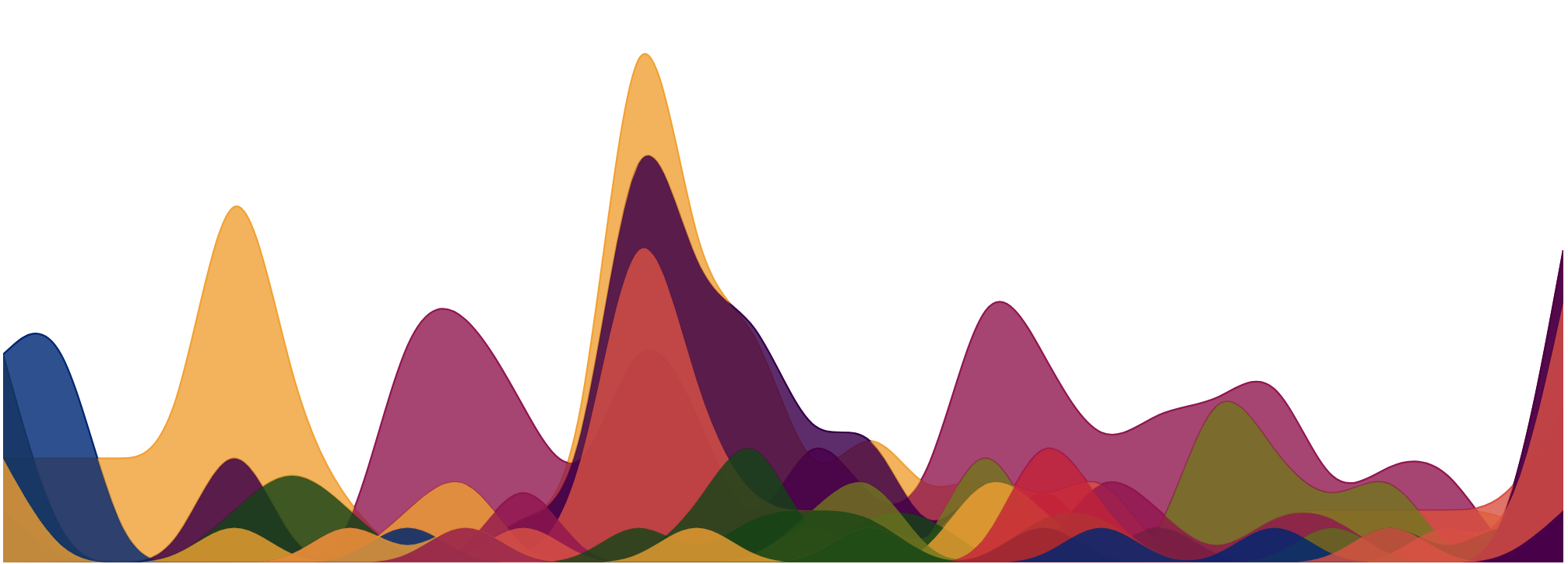
Back when I was a kid, I used to read A LOT of books. Then, over the last couple of years, movies and TV series somehow stole the thunder, and with it, my attention. I did read a few odd books here and there, but not with the same ferocity as before. I could also feel my attention span dwindling so I had trouble reading longer, slower-paced books. It was always easier to consume media to satiate my curiosity and experience something new, especially with the rise of beautiful video essays.
其他回當我還是個孩子的時候,我曾經翻閱了很多。 然后,在過去的幾年中,電影和電視連續劇以某種方式偷走了雷聲,并引起了我的注意。 我確實在這里和那里讀了幾本奇怪的書,但是沒有像以前一樣兇悍。 我也感到自己的注意力在減少,所以我無法閱讀更長的,節奏較慢的書。 使用媒體來滿足我的好奇心和體驗新事物總是容易得多,尤其是隨著精美視頻文章的興起。
Everything changed this year. I learned to let go of the expectation of finishing a book and go back to why I enjoyed reading them in the first place. As a consequence, I’ve read more books in the first six months of this year than I have in the last four years combined. This led me to questions about my reading patterns. How have they evolved over time? What are my favourite genres?
今年一切都變了。 我學會了放下完成一本書的期望,然后回到為什么我喜歡閱讀它們的初衷。 結果,今年前六個月,我閱讀的書籍比過去四年中閱讀的書籍總數還要多。 這使我對我的閱讀方式提出了疑問。 它們是如何隨著時間演變的? 我最喜歡的類型是什么?
I already knew these answers for movies. I’ve been on Letterboxd for a long time. For the uninitiated, Letterboxd is the better version of IMDb. It’s a site with great design, an awesome rating system, and has a great community of people who love movies and make brilliant lists. Above all of these though, the thing I love most is their stats page. A quick glance shows me that I’ve watched movies from 47 countries and my most-watched director, to my absolute dismay, is David Dhawan.
我已經知道電影的這些答案。 我已經在Letterboxd上使用很長時間了。 對于初學者來說,Letterboxd是IMDb的更好版本。 這是一個設計出色,評分系統很棒的網站,并且擁有許多人,他們熱愛電影并做出出色的榜單。 最重要的是,我最喜歡的是其統計信息頁面 。 一眼就看出我看過47個國家/地區的電影,而我最受矚目的導演是大衛·達萬(David Dhawan)。
I wanted something similar for books. My first stop was Goodreads but their stats page was nowhere as good as Letterboxd. I did some more research and came across The StoryGraph. It’s a new site that’s in beta but shows much promise. Each book is tagged with parameters like “mood” and “pace” of the book which they consider while giving personalised recommendations. Think of Spotify’s Echonest algorithm but for books. The nerd in me was delighted.
我想要類似的書籍。 我的第一站是Goodreads,但其統計信息頁面不如Letterboxd好。 我做了更多研究,發現了StoryGraph 。 這是一個處于測試階段的新網站,但前景廣闊。 每本書都標記有參數,例如書的“心情”和“節奏”,他們在提供個性化推薦時會考慮這些參數。 考慮一下Spotify的Echonest算法,但不適合書籍。 我的書呆子很高興。
Logging all the books I’ve read was an arduous task. I had logged some books historically on Goodreads but not the entirety of my reading history. The remaining books I logged through memory, with help of social media posts, notes, letters, old photos, birthday gifts, etc. By the end of it, I logged a paltry 168 books and imported them into The StoryGraph, which has its own stats page, which in turn gave me ideas to create new visualisations. I reached out to Nadia from The StoryGraph and she sent me a dump of all of the data that I had logged even though the feature is not open to public yet (thanks Nadia!).
記錄我所讀的所有書是一項艱巨的任務。 我曾經在Goodreads上記錄過一些書籍,但不是我的全部閱讀歷史。 余下的書是我在社交媒體帖子,筆記,信件,舊照片,生日禮物等的幫助下通過記憶記錄的。到最后,我記錄了僅有的168本書,并將它們導入了StoryStorm,后者擁有自己的統計信息頁面,這反過來給了我一些想法,以創建新的可視化效果。 我從The StoryGraph接觸了Nadia,盡管該功能尚未公開,她還是向我發送了我記錄的所有數據的轉儲(感謝Nadia!) 。
A quick word about the data. I have not logged any comics I’ve read yet. Two reasons why:
關于數據的簡短說明。 我還沒有記錄過我讀過的任何漫畫。 原因有兩個:
I’ve read too many (at least 800 issues of Batman, 300 issues of The Flash, 100 issues of Tinkle, etc.) and logging them is going to take some time.
我讀了太多書(至少800期的《蝙蝠俠》,300期的《 Flash》,100期的《 Tinkle》等),并且記錄它們將花費一些時間。
- Secondly, this would massively skew my data so I’ve not added them as yet. I logged in almost every book I could remember reading. 其次,這將嚴重扭曲我的數據,因此我尚未添加它們。 我登錄了幾乎所有我記得的書。
Also, this is not the entirety of what I’ve read. A lot of old books are not present in the Goodreads/The StoryGraph database so those I haven’t been able to log. Eventually I managed to tag all the ones I imported and came up with some rudimentary visualisations. Let’s dive in!
另外,這還不是我所讀內容的全部。 Goodreads / The StoryGraph數據庫中沒有很多舊書,因此我無法記錄這些舊書。 最終,我設法標記了所有導入的內容,并提出了一些基本的可視化效果。 讓我們潛入吧!
表面潛水 (The Surface Dive)
頁數 (Pages)
For the first one, I bucketed books into three: < 300 pages, 300–500 pages, 500-plus pages to see their progression over time. I started out with a lot of small books and then when I finished my board exams, I read a LOT of large books for the next couple of years. Then I started working and still read a lot of medium sized books. Over the last couple years, I’ve gone back to reading a lot of small and medium-sized books and I hope to read a large book soon.
對于第一個書,我將書籍分為三部分:<300頁,300–500頁,500余頁,以查看它們隨著時間的推移。 我從很多小書開始,然后當我完成董事會考試時,在接下來的幾年里,我讀了很多大書。 然后我開始工作,但仍然閱讀許多中型書籍。 在過去的幾年中,我已經回到閱讀許多中小型書籍,并且希望很快閱讀一本大書籍。
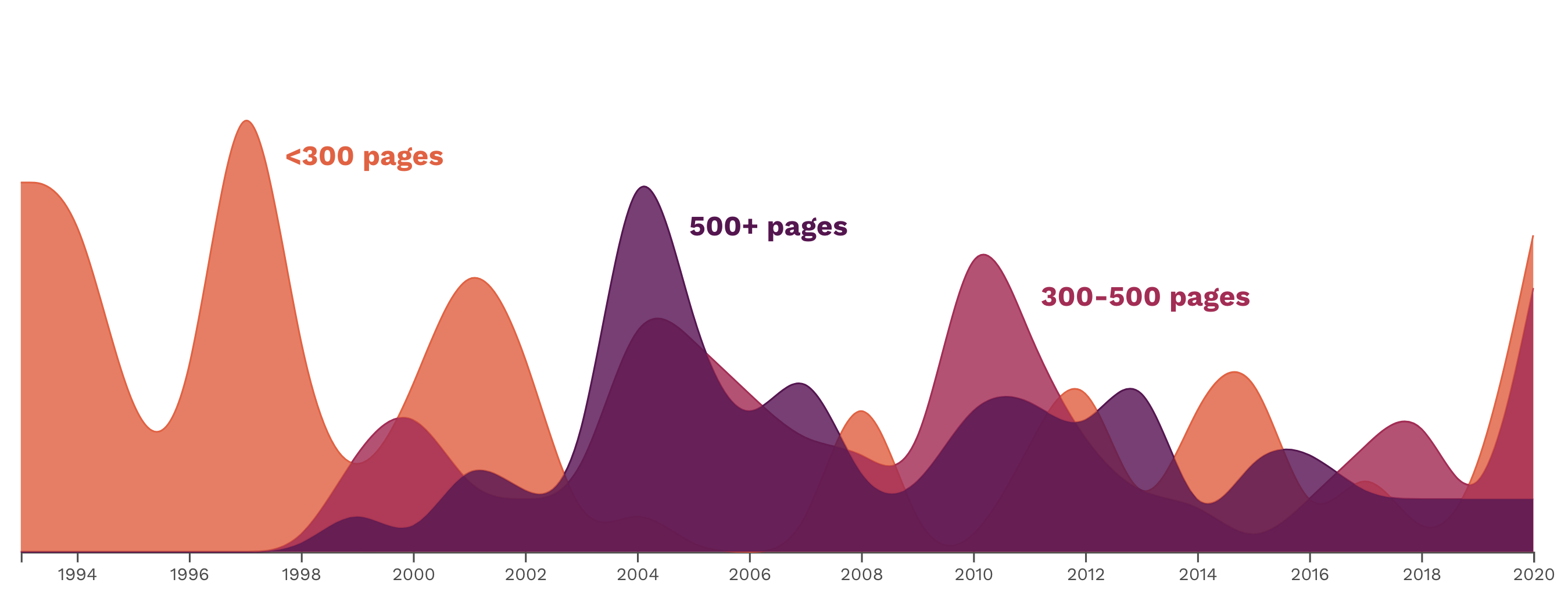
步伐 (Pace)
I then charted pace of the books I’ve read as characterized by The StoryGraph. I generally prefer fast-paced books because I need something that holds my attention. The data backs that up, showing that fast-paced books do make up the majority of what I’ve read. I think (I could be wrong) an author has to be particularly skilled to hold someone’s attention when it’s a slower-paced story.
然后,我繪制了以The StoryGraph為特色的已讀書籍的進度。 通常,我更喜歡快節奏的書,因為我需要吸引我注意力的東西。 數據支持了這一點,表明快節奏的書確實構成了我所閱讀的書的大部分。 我認為(可能是錯誤的)當故事節奏較慢時,作者必須特別熟練才能引起某人的注意。
This made me wonder: Do we have more fast-paced books now to go along with people’s dwindling attention spans? Mapping the publishing landscape would be a worthy subject for a future post, but in the meantime it’s made me consider how the evolution of publishing might impact my own reading patterns.
這讓我感到奇怪: 我們現在是否有更多快節奏的書籍可以與人們日益減少的關注范圍相提并論? 繪制出版前景圖將是未來文章的主題,但與此同時,這使我考慮了出版的發展可能如何影響我自己的閱讀模式。
Anyway, despite my preference for faster pace, I do enjoy reading slow-paced books as well, and I was really surprised to find that almost all the books I’ve read this year are slow-paced. That wasn’t a conscious decision on my part, but could be due to another shift I uncovered in my reading habits:
無論如何,盡管我更喜歡快節奏,但我也喜歡閱讀節奏慢的書,而我發現今年我幾乎閱讀的幾乎所有書籍都是節奏慢的,我感到非常驚訝。 對于我而言,這不是一個有意識的決定,但可能是由于我在閱讀習慣中發現的另一個變化:
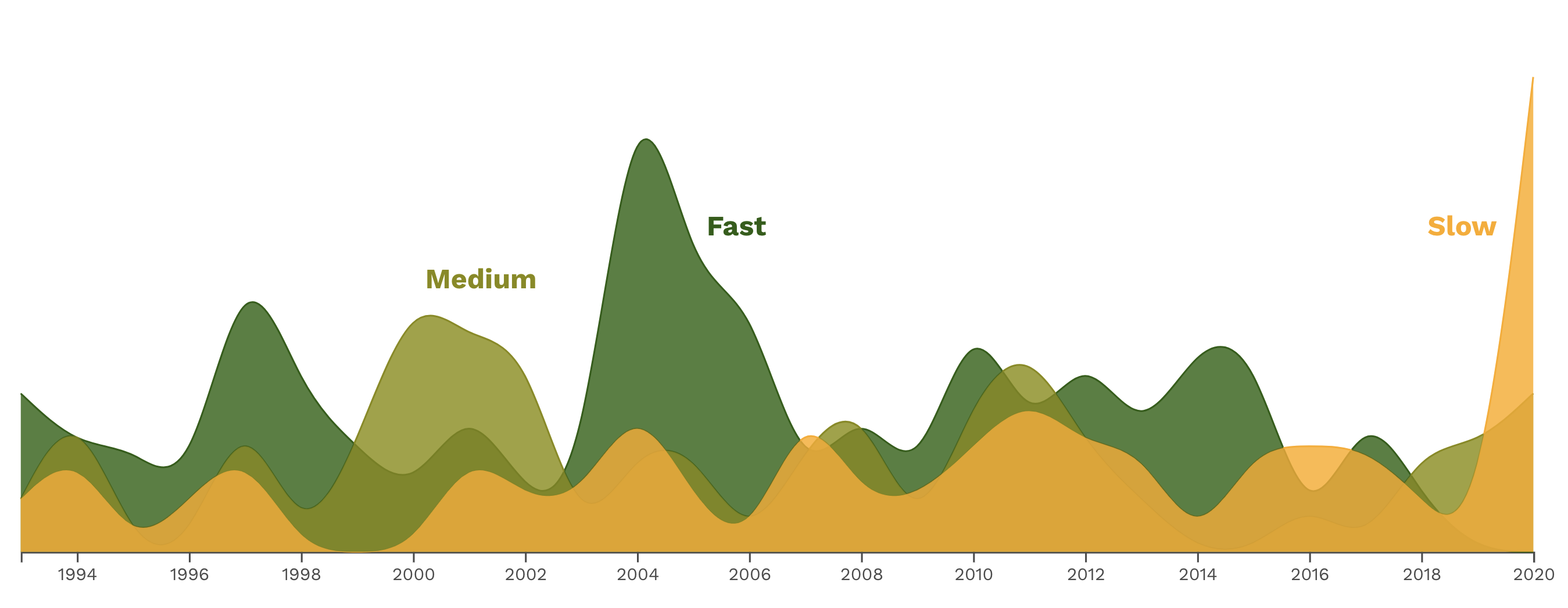
小說 (Fiction)
Going in, I already knew the fiction/non-fiction divide. I’ve always preferred fiction and even scoffed most times at non-fiction. When I was young, non-fiction books were basically reference or self-help books. Now that we have very accessible online tutorials for anything you may want to learn, I didn’t really have the need for them. That was until I read Meggs’ History of Graphic Design in 2016. That book was a catalyst for me to see what other golden knowledge lay hidden in these books. I knew I’ve read a lot of non-fiction recently but was surprised to find that all the books I’ve read this year are non-fiction, including the book I’m currently reading. I think I got tired of watching too many video essays, so went on a knowledge rampage when the lockdown began and hence the spike.
走進去,我已經知道小說/非小說的鴻溝了。 我一直偏愛小說,甚至在大多數時候都不喜歡小說。 我小時候,非小說類書籍基本上是參考書籍或自助書籍。 現在,我們已經為您提供了非常容易訪問的在線教程,您可能想要學習任何東西 ,而我實際上并不需要它們。 直到我讀了Meggs的《 2016年平面設計史》 。這本書對我來說是催化劑,讓我了解這些書中還隱藏著哪些其他黃金知識。 我知道我最近讀過很多非小說類書籍,但驚訝地發現我今年讀過的所有書籍都是非小說類書籍,包括我目前正在閱讀的書籍。 我想我已經厭倦了觀看過多的視頻文章,所以當鎖定開始并因此而激增時,就進行了一次知識橫掃。
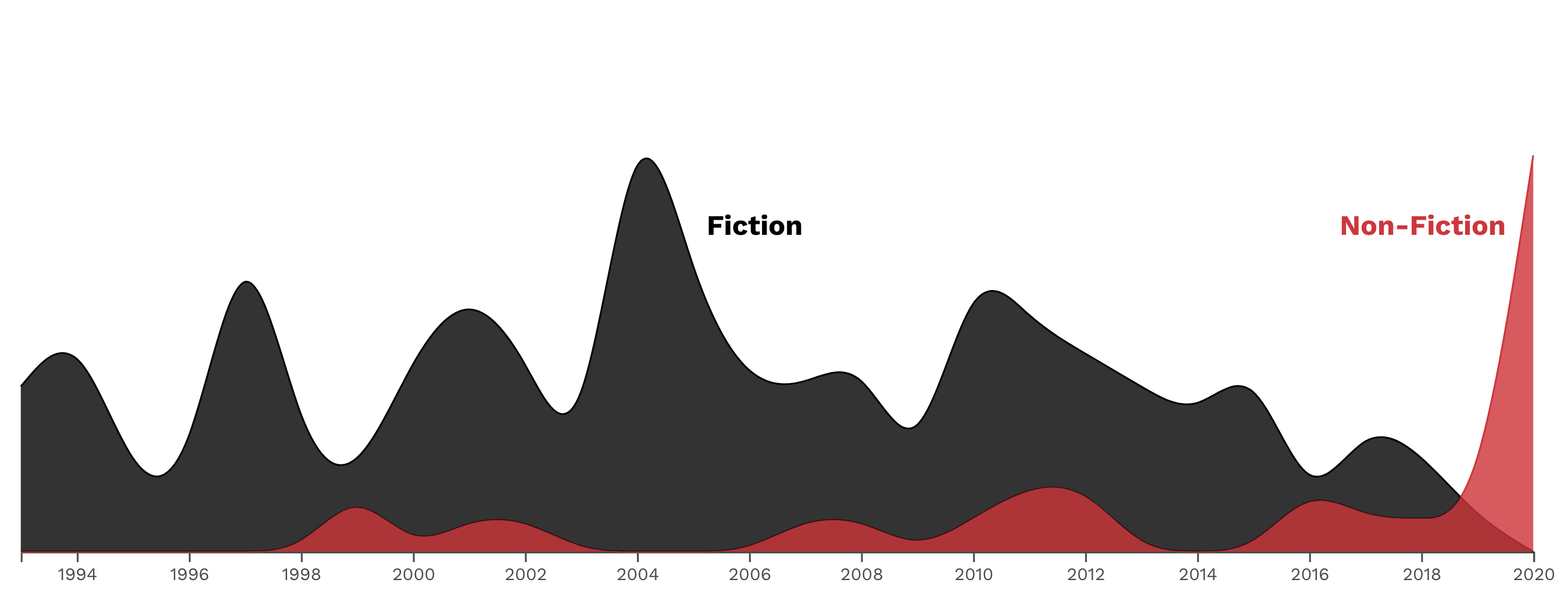
整個歷史 (The Entire History)
The breakouts were cool but I wanted to see my entire history using a single visualisation. Also, since there are multiple genres of a novel, I’ve tagged each book with a “main” genre for this visualisation. This took some time since there are some books that gave me sleepless nights. Is Audrey Niffenegger’s The Time Traveller’s Wife romance, or sci-fi? How about Vikas Swarup’s Q&A? What even is Old Man and the Sea?
這次突破很酷,但我想通過一次可視化查看我的整個歷史。 另外,由于小說有多種類型,因此我為每本書都標記了一種“主要”類型以進行可視化。 這花了一些時間,因為有些書使我徹夜難眠。 奧黛麗·尼芬格(Audrey Niffenegger)的《時間旅行者的妻子》是科幻小說還是科幻小說? Vikas Swarup的問答如何? 老人與海又是什么?
Enter the below visualisation. It looks like a sankey diagram but is spiritually a parallel sets plot (which deals more with categorical data and how it is classified). The genres on the right are ordered by appearance in which I first read them.
輸入以下可視化效果。 它看起來像sankey圖,但從精神上講是一個平行集圖(它更多地處理分類數據及其分類方法) 。 右邊的流派是按照外觀的順序排列的,這是我第一次閱讀它們時的樣子。
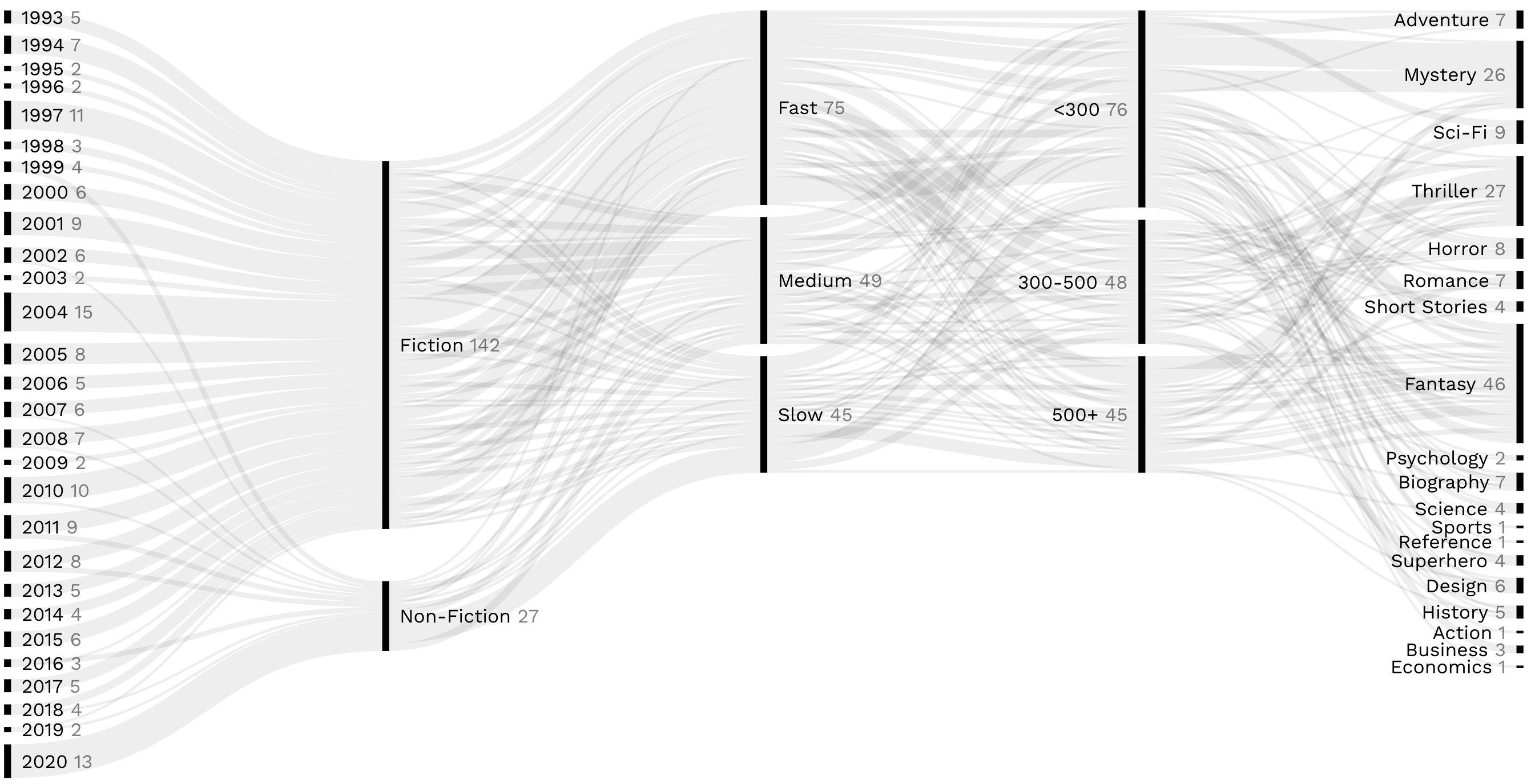
I’ve always been a huge fan of fantasy but was very surprised that I hadn’t picked any fantasy book up until very late into my reading years.
我一直是幻想的忠實擁護者,但令我感到驚訝的是,直到我讀完書的很晚才拿起幻想書。
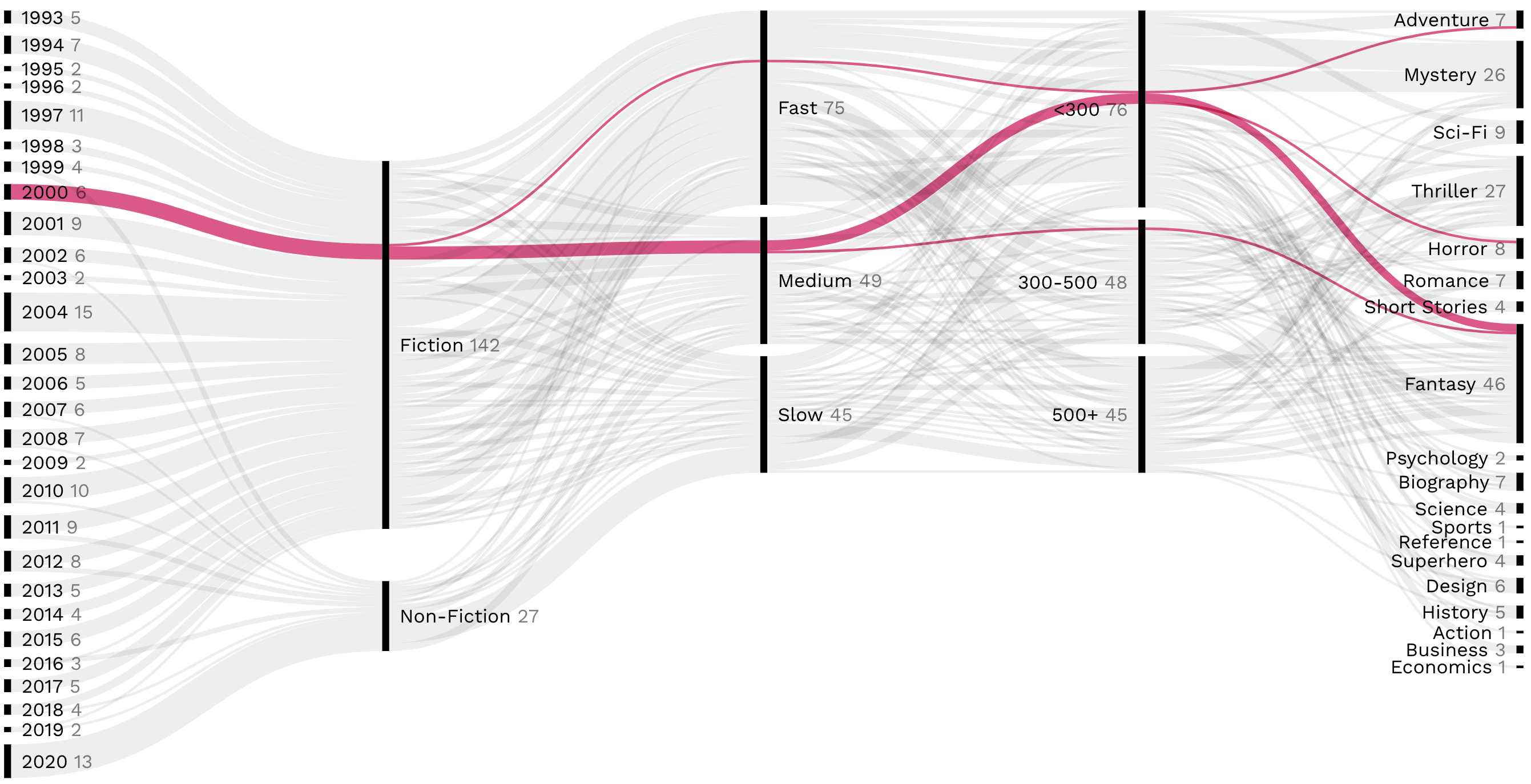
Once I did, I was unstoppable. 2004 was entirely thriller and fantasy!
一旦做完,我就勢不可擋。 2004年完全是驚悚片和幻想片!
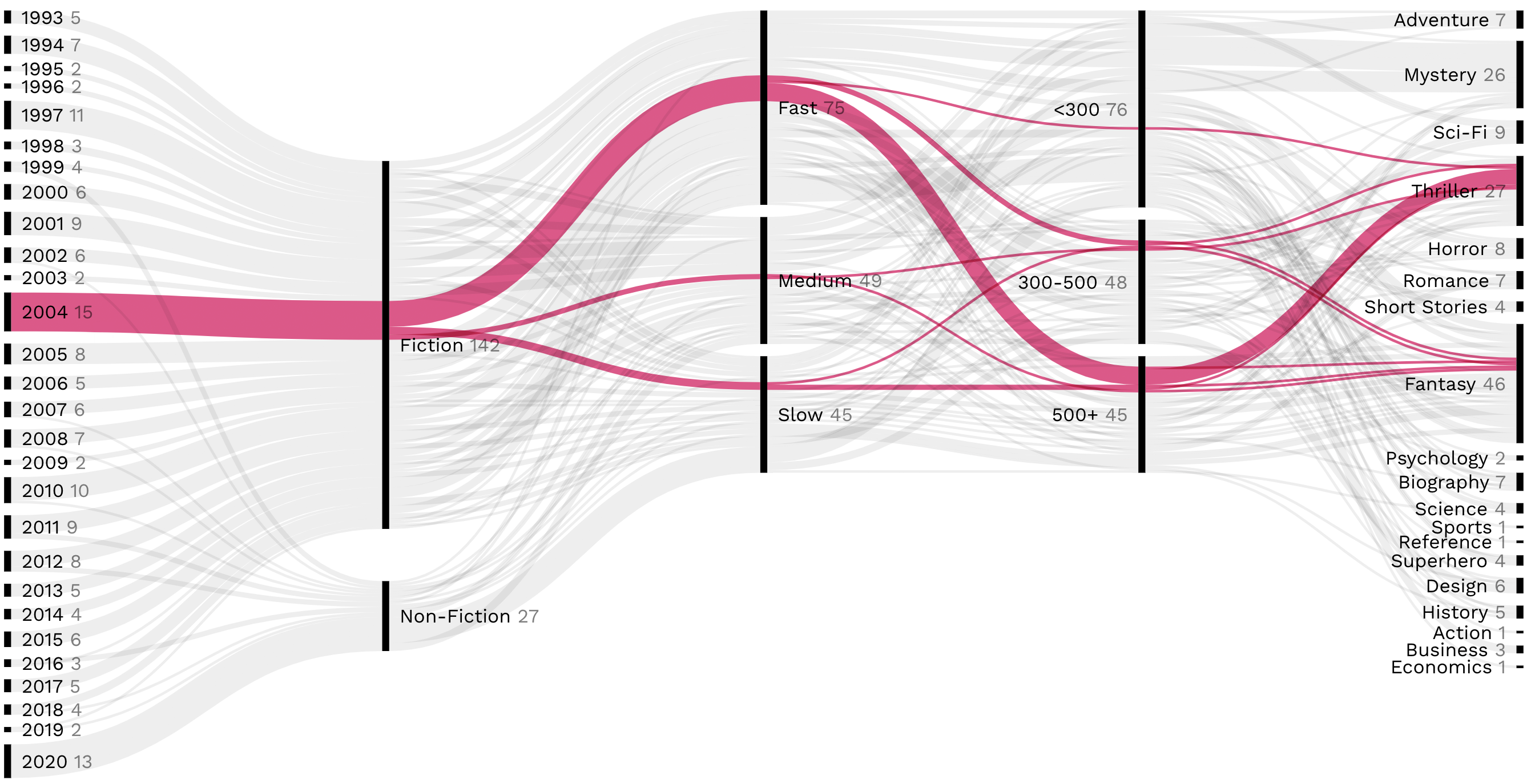
景觀 (The Landscape)
I still wanted to see all the genres I’ve read across the years so I made the titular “Landscape of Literature” for genres. The graph at the beginning of the article is exactly that, but while it looks pretty, it’s not the best for analysis, which is why the Ridgeline Plot is a better option. I’ve accounted for multiple genres of the same book in this visualisation.
我仍然想看看我多年來閱讀的所有流派,所以我為這些流派制作了名義上的“文學風景”。 文章開頭的圖形就是這樣,但是雖然看上去很漂亮,但并不是分析的最佳選擇,這就是為什么Ridgeline圖是更好的選擇的原因。 在這種可視化中,我已經考慮了同一本書的多種風格。
Adventure was a huge theme when I began (Journey to Center of the Earth, Treasure Island) before reading a lot of mystery books (Secret Seven, Famous Five, Hardy Boys, Nancy Drew). Then graduated to fantasy (LOTR, Harry Potter). The spike of mystery, history, and thrillers starting from 2003 can be attributed to The Da Vinci Code and all the books similar to it that I read. Fantasy then makes a comeback because of A Song of Ice and Fire and continues almost through the whole decade. A big twist was Sci-Fi; for a genre that I love so much, I’ve read surprisingly few. In the last couple of years, non-fiction genres like design and business have been surging owing to a lot of reference books I’ve been reading and catching up on.
在我開始( 前往 金銀島 的地球中心之旅 )之前,冒險是一個巨大的主題,然后閱讀了很多神秘書籍(《 秘密七》 ,《 名著五》 ,《 哈代男孩》 ,《 南希·德魯》 )。 然后畢業于幻想( LOTR , 哈利·波特 )。 從2003年開始,神秘,歷史和驚險刺激的高峰可以歸因于《達芬奇密碼》和我所讀過的所有類似書籍。 然后,幻想因《 冰與火之歌》而卷土重來,并持續了整整十年。 科幻小說是一個很大的轉折。 對于我非常喜歡的一種類型,我很少讀過。 在過去的幾年中,由于我一直在閱讀和追趕的大量參考書,諸如設計和商業之類的非小說類書籍一直在蓬勃發展。
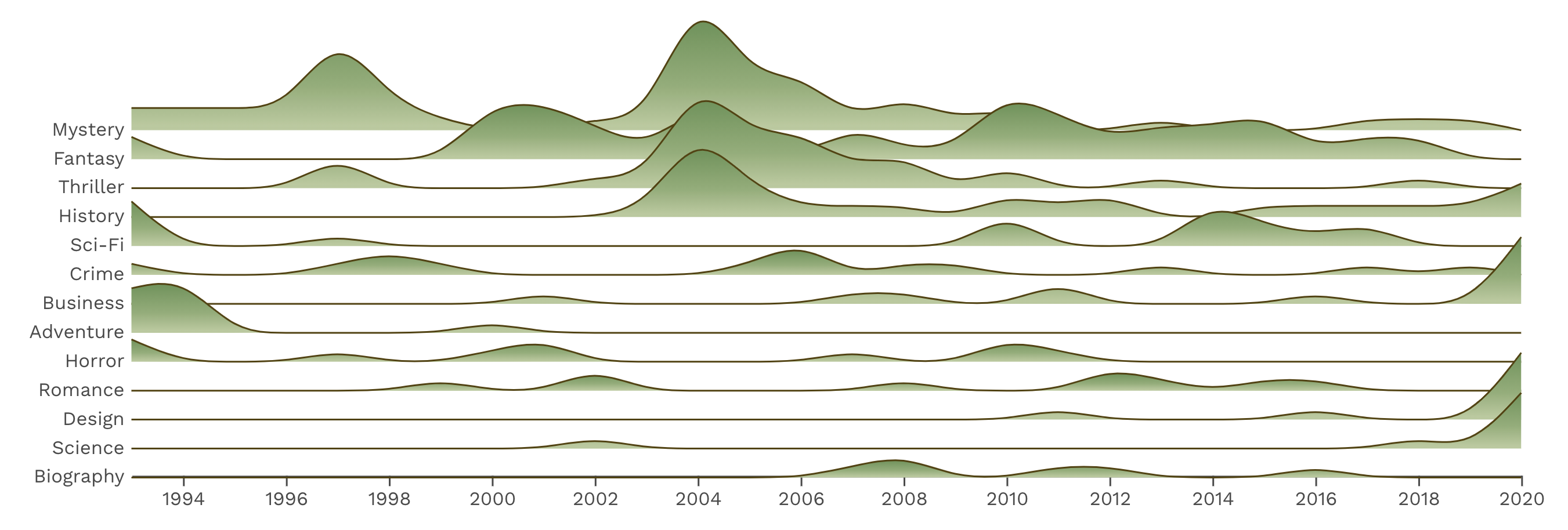
My last visualisation deals with the moods associated with the books I’ve read. Although adventure as a genre tapered out in my childhood, almost all the books I’ve read are adventurous in spirit. The second-most prominent set are dark, mysterious, and tense books that almost increase in frequency on cue as lighthearted tapers off.
我的最后一個可視化處理與我讀過的書有關的情緒。 盡管冒險作為一種流派逐漸消失在我的童年時代,但我讀過的幾乎所有書籍都具有冒險精神。 第二大突出的書籍是黑暗,神秘和緊張的書籍,隨著輕松愉快的逐漸消退,線索的頻率幾乎增加了。
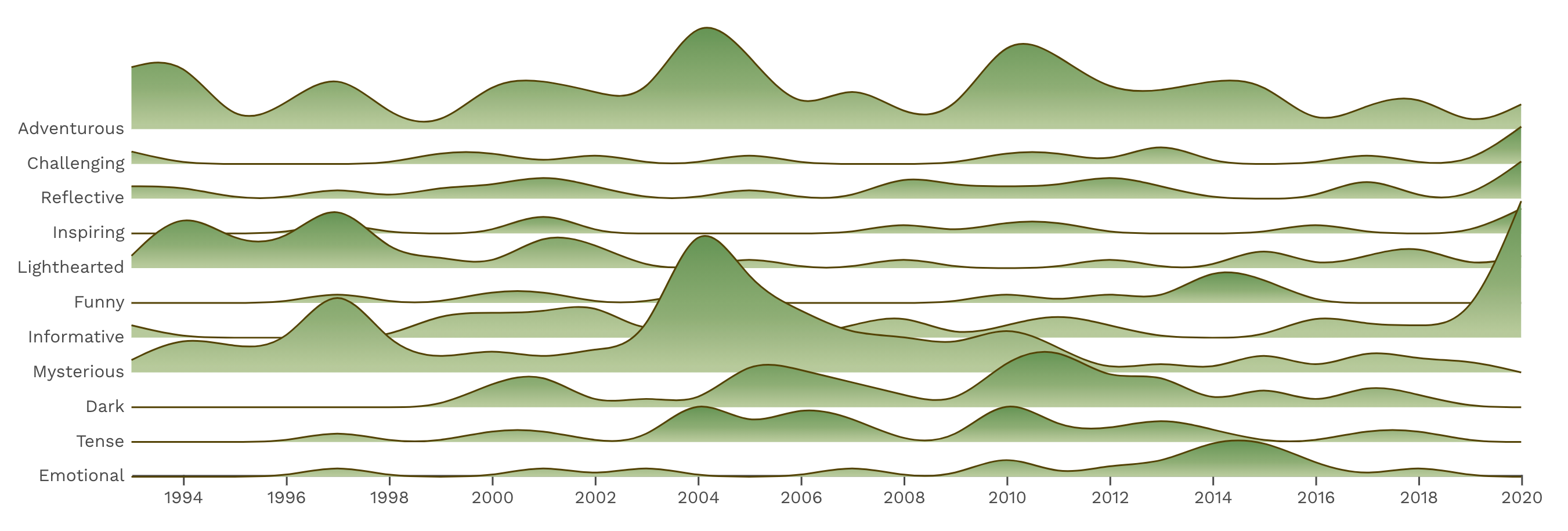
That’s a walk through the history of my reading so far. Feel free to linger around and dive into the data. If you have any suggestions please feel free to drop them in! You could have insights slightly different than mine so please feel free to leave them in too.
到目前為止,我已經了解了我的閱讀歷史。 隨時徘徊并深入研究數據。 如果您有任何建議,請隨時加入! 您可能獲得的見解與我的見解略有不同,因此請隨時將其保留。
This was a great eye-opener for me. Some of my pre-conceived notions were broken, and I picked up on some very interesting patterns I would’ve never seen if I hadn’t visualized it. Why haven’t I read adventure books since I was a kid? Is it because there are very few true adventure books out there now or haven’t I put enough effort in finding them? This is what is great about data and why I love it. Data is a mirror you can use to reflect upon yourself and confront your biases. What you do with it is then up to you.
這讓我大開眼界。 我的一些先入為主的觀念被打破了,我發現了一些非常有趣的模式,如果我不可視化的話,我將永遠不會看到。 為什么我從小就不讀冒險書籍? 是因為現在很少有真正的冒險書籍,還是我沒有花足夠的精力去尋找它們? 這就是數據的優點,也是為什么我喜歡它。 數據是一面鏡子,您可以用來反思自己和面對自己的偏見。 然后,您要做什么就取決于您。
I still have multiple improvements planned for this and more ways to dig into data — author diversity (how eurocentric is my author list?), book formats (when did I start embracing eBooks?), the difference between my “Read” and “Want to Read” lists, etc. I also want to make this a real-time dynamic page à la Letterboxd. Let’s see how I get along with that a month or two from now.
我仍然計劃為此進行多項改進,并采用更多方式來挖掘數據-作者的多樣性(作者列表以歐洲人為中心?) ,書籍的格式(何時開始使用電子書?) ,“閱讀”和“想要”之間的區別閱讀”列表等。我也想使它成為一個實時動態頁面,如“帶信箱”。 讓我們看看從現在起一兩個月后我如何相處。
My name is Nimit Shah and I’m a designer, coder, and data guy who loves integrating the three in interesting ways. This article first appeared on my website (supports dark mode and has an interactive chart!). The code for ridgeplot and the parallel sets can be found on Observable.
我的名字叫Nimit Shah,我是一名設計師,編碼員和數據專家,喜歡以有趣的方式集成這三個工具。 這篇文章首次出現在 我的網站上 (支持暗模式并具有交互式圖表!)。 可以在 Observable 上找到 ridgeplot 和 并行集 的代碼 。

翻譯自: https://medium.com/nightingale/mapping-my-literature-landscape-24d4f7198eb7
前端繪制繪制圖表
本文來自互聯網用戶投稿,該文觀點僅代表作者本人,不代表本站立場。本站僅提供信息存儲空間服務,不擁有所有權,不承擔相關法律責任。 如若轉載,請注明出處:http://www.pswp.cn/news/389204.shtml 繁體地址,請注明出處:http://hk.pswp.cn/news/389204.shtml 英文地址,請注明出處:http://en.pswp.cn/news/389204.shtml
如若內容造成侵權/違法違規/事實不符,請聯系多彩編程網進行投訴反饋email:809451989@qq.com,一經查實,立即刪除!


















